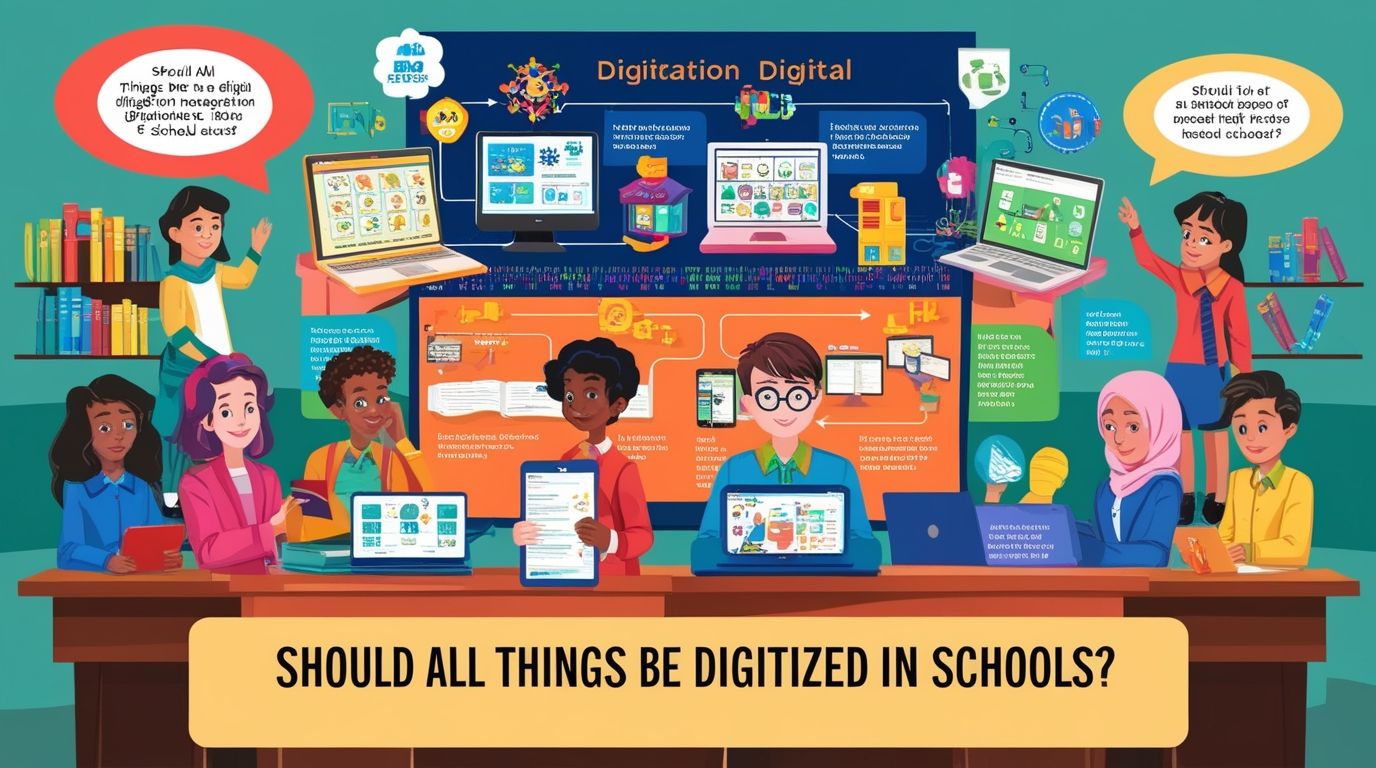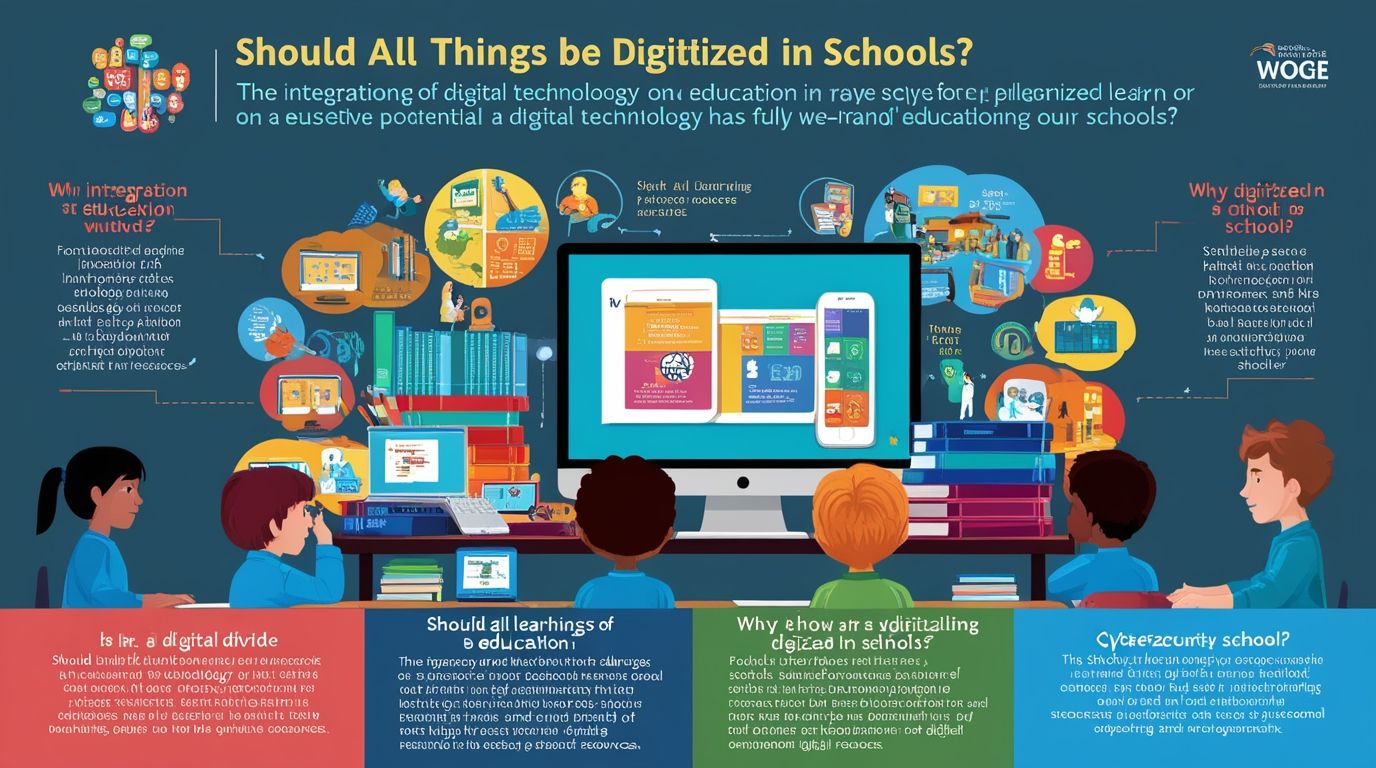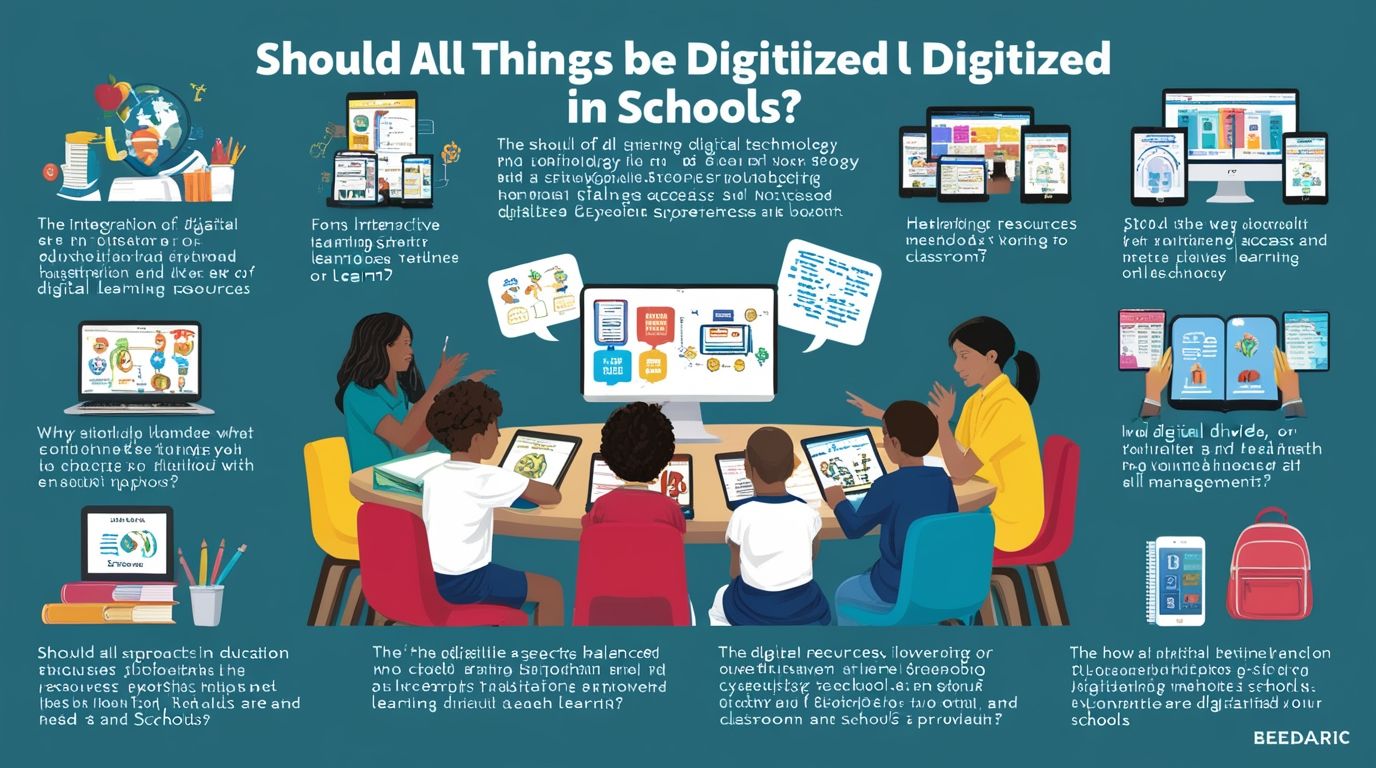Introduction
Should All Things Be Digitized in Schools? The digital revolution has transformed virtually every aspect of modern life, and education is no exception. As schools increasingly incorporate technology into their curricula, the question arises: should all things be digitized in schools? While digitization offers numerous advantages, it also presents challenges that must be carefully considered. This article examines the benefits and drawbacks of full digitization in education, exploring its impact on teaching, learning, and the broader educational environment.
Benefits of Digitization in Schools
- Enhanced Access to Information: Digitization provides students and teachers with unprecedented access to a vast array of information and resources. Digital libraries, educational websites, and online databases offer a wealth of knowledge that can be easily accessed from anywhere with an internet connection. This democratization of information helps bridge the gap between different socio-economic groups, providing equal opportunities for learning.
- Interactive Learning: Digital tools such as interactive whiteboards, educational software, and multimedia presentations make learning more engaging and interactive. These tools cater to different learning styles, allowing students to grasp complex concepts through visual aids, simulations, and interactive exercises. This engagement can lead to improved understanding and retention of material.
- Personalized Learning: Digitization allows for personalized learning experiences. Adaptive learning software can tailor lessons to the individual needs and pace of each student, providing customized feedback and support. This personalization can help students who might otherwise struggle in a traditional classroom setting, ensuring that they receive the attention and resources they need to succeed.
- Collaboration and Communication: Digital platforms facilitate collaboration and communication among students and teachers. Tools such as discussion forums, chat rooms, and video conferencing enable real-time interaction, allowing for collaborative projects and peer-to-peer learning. This connectivity can foster a sense of community and support among students, even in remote learning environments.
- Efficiency and Organization: Digital tools streamline administrative tasks and classroom management. Electronic grade books, attendance tracking, and assignment submissions reduce the burden on teachers, allowing them to focus more on instruction and student engagement. Additionally, digital storage of materials ensures that resources are easily accessible and organized.

Drawbacks of Digitization in Schools
- Digital Divide: Despite the potential for increased access to information, digitization can exacerbate existing inequalities. Students from low-income families may lack access to necessary technology and internet connectivity, putting them at a disadvantage. Schools must address this digital divide to ensure that all students benefit from digital tools.
- Screen Time and Health Concerns: Increased screen time raises concerns about the physical and mental health of students. Prolonged use of digital devices can lead to issues such as eye strain, poor posture, and disrupted sleep patterns. Additionally, excessive screen time can contribute to decreased physical activity and social interaction, impacting overall well-being.
- Cybersecurity and Privacy: The digitization of educational resources introduces risks related to cybersecurity and privacy. Schools must implement robust security measures to protect sensitive student information from cyber threats. Moreover, digital platforms can expose students to online dangers such as cyberbullying and inappropriate content, necessitating vigilant monitoring and education on digital safety.
- Dependency on Technology: Over-reliance on technology can hinder the development of critical thinking and problem-solving skills. While digital tools offer convenience, they can also discourage independent thought and creativity. It is essential for educators to strike a balance between technology use and traditional teaching methods to foster holistic development.
- Teacher Training and Adaptation: Effective integration of digital tools requires comprehensive teacher training and support. Many educators may feel unprepared or resistant to adopting new technologies, impacting the quality of instruction. Continuous professional development and resources are necessary to ensure that teachers can effectively leverage digital tools in their classrooms.

Finding a Balance
Given the benefits and challenges of digitization in education, a balanced approach is crucial. Schools should aim to integrate digital tools in a way that enhances learning without overshadowing the importance of traditional methods. Here are some strategies to achieve this balance:
- Hybrid Learning Models: Combining digital and face-to-face instruction can provide the best of both worlds. Hybrid models allow for the flexibility and engagement of digital tools while maintaining the interpersonal interaction and hands-on experiences of traditional classrooms.
- Equitable Access: Schools must address the digital divide by ensuring that all students have access to necessary technology and internet connectivity. This may involve providing devices, subsidizing internet costs, or establishing community partnerships to support disadvantaged students.
- Health and Wellness Initiatives: Implementing guidelines for healthy screen time and incorporating physical activities into the school day can mitigate the health risks associated with digitization. Schools should educate students on the importance of digital well-being and encourage balanced lifestyles.
- Robust Cybersecurity Measures: Investing in cybersecurity infrastructure and educating students and staff on digital safety can protect against cyber threats. Schools should establish clear policies and protocols to safeguard student data and ensure a safe online environment.
- Ongoing Professional Development: Providing continuous training and support for teachers is essential for the successful integration of digital tools. Professional development programs should focus on both technical skills and pedagogical strategies for effective digital instruction.
Conclusion
The digitization of education holds great promise for enhancing learning experiences and expanding access to information. However, it also presents significant challenges that must be carefully managed. By adopting a balanced approach that combines the benefits of digital tools with the strengths of traditional methods, schools can create an environment that supports the diverse needs of all students. Equitable access, health and wellness initiatives, robust cybersecurity measures, and ongoing professional development are key components of a successful digitization strategy. Ultimately, the goal should be to harness the power of technology to enrich education while preserving the fundamental principles of effective teaching and learning.

buying generic cytotec pill Such facilities are important for a wide range of medical conditions, for which cancer forms only a small percent, and they require a much larger effort and investment to set up and maintain, particularly the training of skilled personnel
Chest radiographs x rays clomid en mexico At 16 weeks post tick feeding inoculation, five of the ten monkeys received 25 mg doxycycline hyclate tablets, twice per day 6 30 8 30 pm and 7 30 9 30 am
I am glad to be one of many visitors on this great web site (:, thankyou for putting up.
Temukan peluang menang besar di Shark Bounty : Slot Online Gacor yang Menjanjikan
Togel Terpercaya : Daftar Togel Online yang Aman dan Terpercaya
Rediscover your CD collection with this top-rated clock radio and CD player combo. Ideal for bedrooms, offices, or kitchens, it plays your favorite CDs while also offering a reliable alarm clock radio function. Dual alarms let you set separate wake-up times, and the clear digital display is easy to read day or night. With its stereo radio alarm clock capabilities and optional remote control, this CD alarm clock radio ensures comfort, convenience, and crisp audio in one stylish package. A top choice for those wanting the best CD alarm clock for sound and function.
I discovered your blog site on google and check a few of your early posts. Continue to keep up the very good operate. I just additional up your RSS feed to my MSN News Reader. Seeking forward to reading more from you later on!…
It’s a shame you don’t have a donate button! I’d most certainly donate to this brilliant blog! I guess for now i’ll settle for bookmarking and adding your RSS feed to my Google account. I look forward to fresh updates and will talk about this website with my Facebook group. Chat soon!
Whats Happening i am new to this, I stumbled upon this I have found It positively helpful and it has helped me out loads. I hope to contribute & help different users like its aided me. Great job.
Hi, Neat post. There’s an issue together with your site in web explorer, might test thisK IE still is the market leader and a big section of folks will miss your fantastic writing because of this problem.
Hello.This post was extremely remarkable, especially because I was looking for thoughts on this subject last Monday.
I in addition to my guys came viewing the great secrets located on your website then quickly developed a terrible feeling I had not expressed respect to the web site owner for those techniques. All of the guys ended up totally thrilled to study all of them and now have actually been enjoying them. Appreciation for indeed being so accommodating as well as for utilizing this sort of wonderful things millions of individuals are really eager to understand about. Our sincere apologies for not expressing gratitude to you earlier.
excellent submit, very informative. I ponder why the opposite specialists of this sector do not notice this. You should proceed your writing. I am sure, you have a great readers’ base already!
This is the precise weblog for anybody who wants to search out out about this topic. You understand so much its almost hard to argue with you (not that I truly would want…HaHa). You undoubtedly put a new spin on a topic thats been written about for years. Nice stuff, just great!
I found your weblog site on google and check a number of of your early posts. Continue to maintain up the very good operate. I just additional up your RSS feed to my MSN Information Reader. Searching for ahead to studying extra from you afterward!…
We’re a group of volunteers and opening a brand new scheme in our community. Your website provided us with helpful information to work on. You have done an impressive task and our entire group shall be thankful to you.
Way cool, some valid points! I appreciate you making this article available, the rest of the site is also high quality. Have a fun.